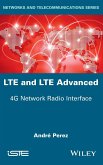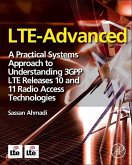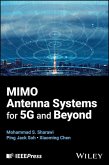Lte Small Cell Optimization
3gpp Evolution to Release 13
Herausgeber: Holma, Harri; Reunanen, Jussi; Toskala, Antti
Lte Small Cell Optimization
3gpp Evolution to Release 13
Herausgeber: Holma, Harri; Reunanen, Jussi; Toskala, Antti
- Gebundenes Buch
- Merkliste
- Auf die Merkliste
- Bewerten Bewerten
- Teilen
- Produkt teilen
- Produkterinnerung
- Produkterinnerung
-This book addresses R&D and standardization activities on LTE small cells and network optimization, focusing on 3GPP evolution to Release 13. In addition, the book is written by experts from Renesas, T-Mobile, Teliasonera and Videotron. The book covers: 1) LTE small cells from specification to products and field results, 2) Latest 3GPP evolution to Release 13 and 3) LTE optimization and learnings from the field---
Andere Kunden interessierten sich auch für
![Small Cell Networks Small Cell Networks]() Holger ClaussenSmall Cell Networks158,99 €
Holger ClaussenSmall Cell Networks158,99 €![From GSM to LTE-Advanced 4Ed C From GSM to LTE-Advanced 4Ed C]() Martin SauterFrom GSM to LTE-Advanced 4Ed C142,99 €
Martin SauterFrom GSM to LTE-Advanced 4Ed C142,99 €![Introduction to Mobile Network Engineering: Gsm, 3g-Wcdma, Lte and the Road to 5g Introduction to Mobile Network Engineering: Gsm, 3g-Wcdma, Lte and the Road to 5g]() Alexander KukushkinIntroduction to Mobile Network Engineering: Gsm, 3g-Wcdma, Lte and the Road to 5g136,99 €
Alexander KukushkinIntroduction to Mobile Network Engineering: Gsm, 3g-Wcdma, Lte and the Road to 5g136,99 €![Lte for Public Safety Lte for Public Safety]() Rainer LiebhartLte for Public Safety128,99 €
Rainer LiebhartLte for Public Safety128,99 €![Lte and Lte Advanced Lte and Lte Advanced]() André PérezLte and Lte Advanced186,99 €
André PérezLte and Lte Advanced186,99 €![Lte-Advanced Lte-Advanced]() Sassan AhmadiLte-Advanced122,99 €
Sassan AhmadiLte-Advanced122,99 €![Mimo Antenna Systems for 5g and Beyond Mimo Antenna Systems for 5g and Beyond]() Xiaoming ChenMimo Antenna Systems for 5g and Beyond156,99 €
Xiaoming ChenMimo Antenna Systems for 5g and Beyond156,99 €-
-
-
-This book addresses R&D and standardization activities on LTE small cells and network optimization, focusing on 3GPP evolution to Release 13. In addition, the book is written by experts from Renesas, T-Mobile, Teliasonera and Videotron. The book covers: 1) LTE small cells from specification to products and field results, 2) Latest 3GPP evolution to Release 13 and 3) LTE optimization and learnings from the field---
Hinweis: Dieser Artikel kann nur an eine deutsche Lieferadresse ausgeliefert werden.
Hinweis: Dieser Artikel kann nur an eine deutsche Lieferadresse ausgeliefert werden.
Produktdetails
- Produktdetails
- Verlag: Wiley
- Seitenzahl: 464
- Erscheinungstermin: 19. Januar 2016
- Englisch
- Abmessung: 250mm x 175mm x 29mm
- Gewicht: 972g
- ISBN-13: 9781118912577
- ISBN-10: 1118912578
- Artikelnr.: 42950095
- Herstellerkennzeichnung
- Libri GmbH
- Europaallee 1
- 36244 Bad Hersfeld
- gpsr@libri.de
- Verlag: Wiley
- Seitenzahl: 464
- Erscheinungstermin: 19. Januar 2016
- Englisch
- Abmessung: 250mm x 175mm x 29mm
- Gewicht: 972g
- ISBN-13: 9781118912577
- ISBN-10: 1118912578
- Artikelnr.: 42950095
- Herstellerkennzeichnung
- Libri GmbH
- Europaallee 1
- 36244 Bad Hersfeld
- gpsr@libri.de
Harri Holma, Antti Toskala and Jussi Reunanen, Nokia (Finland and Thailand).
Preface xiii
Acknowledgements xv
List of Abbreviations xvii
1 Introduction 1
Harri Holma
1.1 Introduction 1
1.2 LTE Global Deployments and Devices 2
1.3 Mobile Data Traffic Growth 3
1.4 LTE Technology Evolution 4
1.5 LTE Spectrum 5
1.6 Small Cell Deployments 6
1.7 Network Optimization 7
1.8 LTE Evolution Beyond Release 13 8
1.9 Summary 9
References 9
2 LTE and LTE Advanced in Releases 8-11 11
Antti Toskala
2.1 Introduction 11
2.2 Releases 8 and 9 LTE 11
2.2.1 Releases 8 and 9 Physical Layer 12
2.2.2 LTE Architecture 17
2.2.3 LTE Radio Protocols 17
2.3 LTE Advanced in Releases 10 and 11 19
2.3.1 Carrier Aggregation 19
2.3.2 Multiple Input Multiple Output Enhancements 23
2.3.3 HetNet Enhanced Inter-cell Interference Coordination 23
2.3.4 Coordinated Multipoint Transmission 25
2.4 UE Capability in Releases 8-11 26
2.5 Conclusions 28
References 28
3 LTE-Advanced Evolution in Releases 12-13 29
Antti Toskala
3.1 Introduction 29
3.2 Machine-Type Communications 29
3.3 Enhanced CoMP 34
3.4 FDD-TDD Carrier Aggregation 35
3.5 WLAN-Radio Interworking 37
3.6 Device-to-Device Communication with LTE 39
3.7 Single Cell Point to Multipoint Transmission 41
3.8 Release 12 UE Capabilities 42
3.9 Conclusions 42
References 43
4 Small Cell Enhancements in Release 12/13 45
Antti Toskala, Timo Lunttila, Tero Henttonen and Jari Lindholm
4.1 Introduction 45
4.2 Small Cell and Dual Connectivity Principles 45
4.3 Dual Connectivity Architecture Principle 46
4.4 Dual Connectivity Protocol Impacts 47
4.5 Dual Connectivity Physical Layer Impacts and Radio Link Monitoring 49
4.6 Other Small Cell Physical Layer Enhancement 53
4.6.1 256QAM for LTE Downlink 53
4.6.2 Small Cell ON/OFF Switching and Enhanced Discovery 53
4.6.3 Power Saving with Small Cell ON/OFF 56
4.6.4 Over the Air Synchronization Between eNodeBs 56
4.7 Release 13 Enhancements 56
4.8 Conclusions 57
References 57
5 Small Cell Deployment Options 59
Harri Holma and Benny Vejlgaard
5.1 Introduction 59
5.2 Small Cell Motivation 60
5.3 Network Architecture Options 60
5.4 Frequency Usage 64
5.5 Selection of Small Cell Location 65
5.6 Indoor Small Cells 67
5.6.1 Distributed Antenna Systems 67
5.6.2 Wi-Fi and Femto Cells 68
5.6.3 Femto Cell Architecture 70
5.6.4 Recommendations 72
5.7 Cost Aspects 72
5.7.1 Macro Network Extension 73
5.7.2 Outdoor Small Cells 73
5.7.3 Outdoor Pico Cluster 73
5.7.4 Indoor Offloading 74
5.8 Summary 74
References 75
6 Small Cell Products 77
Harri Holma and Mikko Simanainen
6.1 Introduction 77
6.2 3GPP Base Station Categories 78
6.3 Micro Base Stations 78
6.4 Pico Base Stations 80
6.5 Femtocells 83
6.6 Low-Power Remote Radio Heads 84
6.6.1 Alternative Remote Radio Head Designs for Indoor Use 86
6.7 Distributed Antenna Systems 87
6.8 Wi-Fi Integration 87
6.9 Wireless Backhaul Products 89
6.10 Summary 90
Reference 90
7 Small Cell Interference Management 91
Rajeev Agrawal, Anand Bedekar, Harri Holma, Suresh Kalyanasundaram, Klaus
Pedersen and Beatriz Soret
7.1 Introduction 91
7.2 Packet Scheduling Solutions 93
7.3 Enhanced Inter-cell Interference Coordination 97
7.3.1 Concept Description 97
7.3.2 Performance and Algorithms 101
7.4 Enhanced Coordinated Multipoint (eCoMP) 110
7.5 Coordinated Multipoint (CoMP) 114
7.6 Summary 119
References 120
8 Small Cell Optimization 121
Harri Holma, Klaus Pedersen, Claudio Rosa, Anand Bedekar and Hua Wang
8.1 Introduction 121
8.2 HetNet Mobility Optimization 122
8.3 Inter-site Carrier Aggregation with Dual Connectivity 126
8.3.1 User Data Rates with Inter-site Carrier Aggregation 126
8.3.2 Mobility with Dual Connectivity 131
8.4 Ultra Dense Network Interference Management 135
8.4.1 Ultra Dense Network Characteristics 135
8.4.2 Proactive Time-Domain Inter-cell Interference Coordination 136
8.4.3 Reactive Carrier-Based Inter-cell Interference Coordination 138
8.5 Power Saving with Small Cell On/Off 139
8.6 Multivendor Macro Cell and Small Cells 141
8.7 Summary 143
References 143
9 Learnings from Small Cell Deployments 145
Brian Olsen and Harri Holma
9.1 Introduction 145
9.2 Small Cell Motivations by Mobile Operators 145
9.3 Small Cell Challenges and Solutions 146
9.4 Summary of Learnings from Small Cell Deployments 147
9.5 Installation Considerations 151
9.6 Example Small Cell Case Study 152
9.6.1 Site Solution and Backhaul 152
9.6.2 Coverage and User Data Rates 153
9.6.3 Macro Cell Offloading and Capacity 154
9.6.4 KPIs in Network Statistics 155
9.6.5 Mobility Performance 156
9.6.6 Parameter and RF Optimization 157
9.7 Summary 158
10 LTE Unlicensed 159
Antti Toskala and Harri Holma
10.1 Introduction 159
10.2 Unlicensed Spectrum 160
10.3 Operation Environment 161
10.4 Motivation for the Use of Unlicensed Spectrum with LTE 162
10.5 Key Requirements for 5 GHz Band Coexistence 162
10.6 LTE Principle on Unlicensed Band 164
10.7 LTE Performance on the Unlicensed Band 165
10.8 Coexistence Performance 166
10.9 Coverage with LTE in 5 GHz Band 170
10.10 Standardization 172
10.11 Conclusions 172
References 173
11 LTE Macro Cell Evolution 175
Mihai Enescu, Amitava Ghosh, Bishwarup Mondal and Antti Toskala
11.1 Introduction 175
11.2 Network-Assisted Interference Cancellation 176
11.3 Evolution of Antenna Array Technology 181
11.4 Deployment Scenarios for Antenna Arrays 182
11.5 Massive-MIMO Supported by LTE 187
11.5.1 Sectorization (Vertical)-Based Approaches 187
11.5.2 Reciprocity-Based Approaches 188
11.6 Further LTE Multi-antenna Standardization 189
11.7 Release 13 Advanced Receiver Enhancements 192
11.8 Conclusions 192
References 193
12 LTE Key Performance Indicator Optimization 195
Jussi Reunanen, Jari Salo and Riku Luostari
12.1 Introduction 195
12.2 Key Performance Indicators 196
12.3 Physical Layer Optimization 197
12.4 Call Setup 200
12.4.1 Random Access Setup 202
12.4.2 RRC Connection Setup 208
12.4.3 E-RAB Setup 215
12.5 E-RAB Drop 218
12.5.1 Handover Performance 218
12.5.2 UE-Triggered RRC Connection Re-establishments 222
12.5.3 eNodeB-triggered RRC Connection Re-establishments 226
12.6 Handover and Mobility Optimization 228
12.7 Throughput Optimization 232
12.7.1 MIMO Multi-stream Usage Optimization 234
12.8 High-Speed Train Optimization 243
12.9 Network Density Benchmarking 246
12.10 Summary 247
References 248
13 Capacity Optimization 249
Jussi Reunanen, Riku Luostari and Harri Holma
13.1 Introduction 249
13.2 Traffic Profiles in Mass Events 251
13.3 Uplink Interference Management 255
13.3.1 PUSCH 257
13.3.2 PUCCH 265
13.3.3 RACH and RRC Setup Success Rate 265
13.3.4 Centralized RAN 269
13.4 Downlink Interference Management 270
13.4.1 PDSCH 271
13.4.2 Physical Downlink Control Channel 276
13.5 Signalling Load and Number of Connected Users Dimensioning 279
13.5.1 Signalling Load 280
13.5.2 RRC-Connected Users 280
13.6 Load Balancing 284
13.7 Capacity Bottleneck Analysis 286
13.8 Summary 291
References 292
14 VoLTE Optimization 293
Riku Luostari, Jari Salo, Jussi Reunanen and Harri Holma
14.1 Introduction 293
14.2 Voice Options for LTE Smartphones 293
14.3 Circuit Switched Fallback 294
14.3.1 Basic Concepts 294
14.3.2 CSFB Call Setup Time, Transition to Target RAT 296
14.3.3 CSFB Call Setup Success Rate 302
14.3.4 Return to LTE after CSFB Call 302
14.4 Voice over LTE 307
14.4.1 Setup Success Rate and Drop Rate 307
14.4.2 TTI Bundling and RLC Segmentation 310
14.4.3 Semi-persistent Scheduling 312
14.4.4 Packet Bundling 314
14.4.5 Re-establishment with Radio Preparations 315
14.4.6 Voice Quality on VoLTE 315
14.5 Single Radio Voice Call Continuity 322
14.5.1 Signalling Flows 322
14.5.2 Performance 326
14.6 Summary 331
References 331
15 Inter-layer Mobility Optimization 333
Jari Salo and Jussi Reunanen
15.1 Introduction 333
15.2 Inter-layer Idle Mode Mobility and Measurements 334
15.2.1 Initial Cell Selection and Minimum Criteria for UE to Camp on a Cell
334
15.2.2 Summary of Cell Reselection Rules 336
15.2.3 Idle Mode Measurements 338
15.3 Inter-layer Connected Mode Measurements 344
15.4 Inter-layer Mobility for Coverage-Limited Network 350
15.4.1 Basic Concepts 350
15.4.2 Mapping Throughput Target to SINR, RSRQ and RSRP 353
15.4.3 Inter-layer Mobility Example #1 (Non-equal Priority Non-equal
Bandwidth LTE Layers) 361
15.4.4 Inter-layer Mobility Example #2 (Equal Priority Equal Bandwidth LTE
Layers) 368
15.5 Inter-layer Mobility for Capacity-Limited Networks 370
15.5.1 Static Load Balancing via Mobility Thresholds 371
15.5.2 Dynamic Load Balancing via eNodeB Algorithms 375
15.6 Summary 377
References 377
16 Smartphone Optimization 379
Rafael Sanchez-Mejias, Laurent Nöel and Harri Holma
16.1 Introduction 379
16.2 Smartphone Traffic Analysis in LTE Networks 380
16.2.1 Data Volumes and Asymmetry 380
16.2.2 Traffic-Related Signalling 381
16.2.3 Mobility-Related Signalling 382
16.2.4 User Connectivity 382
16.3 Smartphone Power Consumption Optimization 384
16.3.1 Impact of Downlink Carrier Aggregation 384
16.3.2 Impact of Discontinuous Reception 385
16.4 Smartphone Operating Systems 391
16.5 Messaging Applications 391
16.6 Streaming Applications 393
16.7 Voice over LTE 394
16.7.1 VoLTE System Architecture 395
16.7.2 VoLTE Performance Analysis 396
16.7.3 Standby Performance 404
16.7.4 Impact of Network Loading and Radio Quality 405
16.8 Smartphone Battery, Baseband and RF Design Aspects 406
16.8.1 Trends in Battery Capacity 406
16.8.2 Trends in Cellular Chipset Power Consumption 409
16.8.3 Impact of Small Cells on Smartphone Power Consumption 412
16.9 Summary 421
References 421
17 Further Outlook for LTE Evolution and 5G 423
Antti Toskala and Karri Ranta-aho
17.1 Introduction 423
17.2 Further LTE-Advanced Beyond Release 13 423
17.3 Towards 5G 426
17.4 5G Spectrum 427
17.5 Key 5G Radio Technologies 428
17.6 Expected 5G Schedule 430
17.7 Conclusions 432
References 432
Index 433
Acknowledgements xv
List of Abbreviations xvii
1 Introduction 1
Harri Holma
1.1 Introduction 1
1.2 LTE Global Deployments and Devices 2
1.3 Mobile Data Traffic Growth 3
1.4 LTE Technology Evolution 4
1.5 LTE Spectrum 5
1.6 Small Cell Deployments 6
1.7 Network Optimization 7
1.8 LTE Evolution Beyond Release 13 8
1.9 Summary 9
References 9
2 LTE and LTE Advanced in Releases 8-11 11
Antti Toskala
2.1 Introduction 11
2.2 Releases 8 and 9 LTE 11
2.2.1 Releases 8 and 9 Physical Layer 12
2.2.2 LTE Architecture 17
2.2.3 LTE Radio Protocols 17
2.3 LTE Advanced in Releases 10 and 11 19
2.3.1 Carrier Aggregation 19
2.3.2 Multiple Input Multiple Output Enhancements 23
2.3.3 HetNet Enhanced Inter-cell Interference Coordination 23
2.3.4 Coordinated Multipoint Transmission 25
2.4 UE Capability in Releases 8-11 26
2.5 Conclusions 28
References 28
3 LTE-Advanced Evolution in Releases 12-13 29
Antti Toskala
3.1 Introduction 29
3.2 Machine-Type Communications 29
3.3 Enhanced CoMP 34
3.4 FDD-TDD Carrier Aggregation 35
3.5 WLAN-Radio Interworking 37
3.6 Device-to-Device Communication with LTE 39
3.7 Single Cell Point to Multipoint Transmission 41
3.8 Release 12 UE Capabilities 42
3.9 Conclusions 42
References 43
4 Small Cell Enhancements in Release 12/13 45
Antti Toskala, Timo Lunttila, Tero Henttonen and Jari Lindholm
4.1 Introduction 45
4.2 Small Cell and Dual Connectivity Principles 45
4.3 Dual Connectivity Architecture Principle 46
4.4 Dual Connectivity Protocol Impacts 47
4.5 Dual Connectivity Physical Layer Impacts and Radio Link Monitoring 49
4.6 Other Small Cell Physical Layer Enhancement 53
4.6.1 256QAM for LTE Downlink 53
4.6.2 Small Cell ON/OFF Switching and Enhanced Discovery 53
4.6.3 Power Saving with Small Cell ON/OFF 56
4.6.4 Over the Air Synchronization Between eNodeBs 56
4.7 Release 13 Enhancements 56
4.8 Conclusions 57
References 57
5 Small Cell Deployment Options 59
Harri Holma and Benny Vejlgaard
5.1 Introduction 59
5.2 Small Cell Motivation 60
5.3 Network Architecture Options 60
5.4 Frequency Usage 64
5.5 Selection of Small Cell Location 65
5.6 Indoor Small Cells 67
5.6.1 Distributed Antenna Systems 67
5.6.2 Wi-Fi and Femto Cells 68
5.6.3 Femto Cell Architecture 70
5.6.4 Recommendations 72
5.7 Cost Aspects 72
5.7.1 Macro Network Extension 73
5.7.2 Outdoor Small Cells 73
5.7.3 Outdoor Pico Cluster 73
5.7.4 Indoor Offloading 74
5.8 Summary 74
References 75
6 Small Cell Products 77
Harri Holma and Mikko Simanainen
6.1 Introduction 77
6.2 3GPP Base Station Categories 78
6.3 Micro Base Stations 78
6.4 Pico Base Stations 80
6.5 Femtocells 83
6.6 Low-Power Remote Radio Heads 84
6.6.1 Alternative Remote Radio Head Designs for Indoor Use 86
6.7 Distributed Antenna Systems 87
6.8 Wi-Fi Integration 87
6.9 Wireless Backhaul Products 89
6.10 Summary 90
Reference 90
7 Small Cell Interference Management 91
Rajeev Agrawal, Anand Bedekar, Harri Holma, Suresh Kalyanasundaram, Klaus
Pedersen and Beatriz Soret
7.1 Introduction 91
7.2 Packet Scheduling Solutions 93
7.3 Enhanced Inter-cell Interference Coordination 97
7.3.1 Concept Description 97
7.3.2 Performance and Algorithms 101
7.4 Enhanced Coordinated Multipoint (eCoMP) 110
7.5 Coordinated Multipoint (CoMP) 114
7.6 Summary 119
References 120
8 Small Cell Optimization 121
Harri Holma, Klaus Pedersen, Claudio Rosa, Anand Bedekar and Hua Wang
8.1 Introduction 121
8.2 HetNet Mobility Optimization 122
8.3 Inter-site Carrier Aggregation with Dual Connectivity 126
8.3.1 User Data Rates with Inter-site Carrier Aggregation 126
8.3.2 Mobility with Dual Connectivity 131
8.4 Ultra Dense Network Interference Management 135
8.4.1 Ultra Dense Network Characteristics 135
8.4.2 Proactive Time-Domain Inter-cell Interference Coordination 136
8.4.3 Reactive Carrier-Based Inter-cell Interference Coordination 138
8.5 Power Saving with Small Cell On/Off 139
8.6 Multivendor Macro Cell and Small Cells 141
8.7 Summary 143
References 143
9 Learnings from Small Cell Deployments 145
Brian Olsen and Harri Holma
9.1 Introduction 145
9.2 Small Cell Motivations by Mobile Operators 145
9.3 Small Cell Challenges and Solutions 146
9.4 Summary of Learnings from Small Cell Deployments 147
9.5 Installation Considerations 151
9.6 Example Small Cell Case Study 152
9.6.1 Site Solution and Backhaul 152
9.6.2 Coverage and User Data Rates 153
9.6.3 Macro Cell Offloading and Capacity 154
9.6.4 KPIs in Network Statistics 155
9.6.5 Mobility Performance 156
9.6.6 Parameter and RF Optimization 157
9.7 Summary 158
10 LTE Unlicensed 159
Antti Toskala and Harri Holma
10.1 Introduction 159
10.2 Unlicensed Spectrum 160
10.3 Operation Environment 161
10.4 Motivation for the Use of Unlicensed Spectrum with LTE 162
10.5 Key Requirements for 5 GHz Band Coexistence 162
10.6 LTE Principle on Unlicensed Band 164
10.7 LTE Performance on the Unlicensed Band 165
10.8 Coexistence Performance 166
10.9 Coverage with LTE in 5 GHz Band 170
10.10 Standardization 172
10.11 Conclusions 172
References 173
11 LTE Macro Cell Evolution 175
Mihai Enescu, Amitava Ghosh, Bishwarup Mondal and Antti Toskala
11.1 Introduction 175
11.2 Network-Assisted Interference Cancellation 176
11.3 Evolution of Antenna Array Technology 181
11.4 Deployment Scenarios for Antenna Arrays 182
11.5 Massive-MIMO Supported by LTE 187
11.5.1 Sectorization (Vertical)-Based Approaches 187
11.5.2 Reciprocity-Based Approaches 188
11.6 Further LTE Multi-antenna Standardization 189
11.7 Release 13 Advanced Receiver Enhancements 192
11.8 Conclusions 192
References 193
12 LTE Key Performance Indicator Optimization 195
Jussi Reunanen, Jari Salo and Riku Luostari
12.1 Introduction 195
12.2 Key Performance Indicators 196
12.3 Physical Layer Optimization 197
12.4 Call Setup 200
12.4.1 Random Access Setup 202
12.4.2 RRC Connection Setup 208
12.4.3 E-RAB Setup 215
12.5 E-RAB Drop 218
12.5.1 Handover Performance 218
12.5.2 UE-Triggered RRC Connection Re-establishments 222
12.5.3 eNodeB-triggered RRC Connection Re-establishments 226
12.6 Handover and Mobility Optimization 228
12.7 Throughput Optimization 232
12.7.1 MIMO Multi-stream Usage Optimization 234
12.8 High-Speed Train Optimization 243
12.9 Network Density Benchmarking 246
12.10 Summary 247
References 248
13 Capacity Optimization 249
Jussi Reunanen, Riku Luostari and Harri Holma
13.1 Introduction 249
13.2 Traffic Profiles in Mass Events 251
13.3 Uplink Interference Management 255
13.3.1 PUSCH 257
13.3.2 PUCCH 265
13.3.3 RACH and RRC Setup Success Rate 265
13.3.4 Centralized RAN 269
13.4 Downlink Interference Management 270
13.4.1 PDSCH 271
13.4.2 Physical Downlink Control Channel 276
13.5 Signalling Load and Number of Connected Users Dimensioning 279
13.5.1 Signalling Load 280
13.5.2 RRC-Connected Users 280
13.6 Load Balancing 284
13.7 Capacity Bottleneck Analysis 286
13.8 Summary 291
References 292
14 VoLTE Optimization 293
Riku Luostari, Jari Salo, Jussi Reunanen and Harri Holma
14.1 Introduction 293
14.2 Voice Options for LTE Smartphones 293
14.3 Circuit Switched Fallback 294
14.3.1 Basic Concepts 294
14.3.2 CSFB Call Setup Time, Transition to Target RAT 296
14.3.3 CSFB Call Setup Success Rate 302
14.3.4 Return to LTE after CSFB Call 302
14.4 Voice over LTE 307
14.4.1 Setup Success Rate and Drop Rate 307
14.4.2 TTI Bundling and RLC Segmentation 310
14.4.3 Semi-persistent Scheduling 312
14.4.4 Packet Bundling 314
14.4.5 Re-establishment with Radio Preparations 315
14.4.6 Voice Quality on VoLTE 315
14.5 Single Radio Voice Call Continuity 322
14.5.1 Signalling Flows 322
14.5.2 Performance 326
14.6 Summary 331
References 331
15 Inter-layer Mobility Optimization 333
Jari Salo and Jussi Reunanen
15.1 Introduction 333
15.2 Inter-layer Idle Mode Mobility and Measurements 334
15.2.1 Initial Cell Selection and Minimum Criteria for UE to Camp on a Cell
334
15.2.2 Summary of Cell Reselection Rules 336
15.2.3 Idle Mode Measurements 338
15.3 Inter-layer Connected Mode Measurements 344
15.4 Inter-layer Mobility for Coverage-Limited Network 350
15.4.1 Basic Concepts 350
15.4.2 Mapping Throughput Target to SINR, RSRQ and RSRP 353
15.4.3 Inter-layer Mobility Example #1 (Non-equal Priority Non-equal
Bandwidth LTE Layers) 361
15.4.4 Inter-layer Mobility Example #2 (Equal Priority Equal Bandwidth LTE
Layers) 368
15.5 Inter-layer Mobility for Capacity-Limited Networks 370
15.5.1 Static Load Balancing via Mobility Thresholds 371
15.5.2 Dynamic Load Balancing via eNodeB Algorithms 375
15.6 Summary 377
References 377
16 Smartphone Optimization 379
Rafael Sanchez-Mejias, Laurent Nöel and Harri Holma
16.1 Introduction 379
16.2 Smartphone Traffic Analysis in LTE Networks 380
16.2.1 Data Volumes and Asymmetry 380
16.2.2 Traffic-Related Signalling 381
16.2.3 Mobility-Related Signalling 382
16.2.4 User Connectivity 382
16.3 Smartphone Power Consumption Optimization 384
16.3.1 Impact of Downlink Carrier Aggregation 384
16.3.2 Impact of Discontinuous Reception 385
16.4 Smartphone Operating Systems 391
16.5 Messaging Applications 391
16.6 Streaming Applications 393
16.7 Voice over LTE 394
16.7.1 VoLTE System Architecture 395
16.7.2 VoLTE Performance Analysis 396
16.7.3 Standby Performance 404
16.7.4 Impact of Network Loading and Radio Quality 405
16.8 Smartphone Battery, Baseband and RF Design Aspects 406
16.8.1 Trends in Battery Capacity 406
16.8.2 Trends in Cellular Chipset Power Consumption 409
16.8.3 Impact of Small Cells on Smartphone Power Consumption 412
16.9 Summary 421
References 421
17 Further Outlook for LTE Evolution and 5G 423
Antti Toskala and Karri Ranta-aho
17.1 Introduction 423
17.2 Further LTE-Advanced Beyond Release 13 423
17.3 Towards 5G 426
17.4 5G Spectrum 427
17.5 Key 5G Radio Technologies 428
17.6 Expected 5G Schedule 430
17.7 Conclusions 432
References 432
Index 433
Preface xiii
Acknowledgements xv
List of Abbreviations xvii
1 Introduction 1
Harri Holma
1.1 Introduction 1
1.2 LTE Global Deployments and Devices 2
1.3 Mobile Data Traffic Growth 3
1.4 LTE Technology Evolution 4
1.5 LTE Spectrum 5
1.6 Small Cell Deployments 6
1.7 Network Optimization 7
1.8 LTE Evolution Beyond Release 13 8
1.9 Summary 9
References 9
2 LTE and LTE Advanced in Releases 8-11 11
Antti Toskala
2.1 Introduction 11
2.2 Releases 8 and 9 LTE 11
2.2.1 Releases 8 and 9 Physical Layer 12
2.2.2 LTE Architecture 17
2.2.3 LTE Radio Protocols 17
2.3 LTE Advanced in Releases 10 and 11 19
2.3.1 Carrier Aggregation 19
2.3.2 Multiple Input Multiple Output Enhancements 23
2.3.3 HetNet Enhanced Inter-cell Interference Coordination 23
2.3.4 Coordinated Multipoint Transmission 25
2.4 UE Capability in Releases 8-11 26
2.5 Conclusions 28
References 28
3 LTE-Advanced Evolution in Releases 12-13 29
Antti Toskala
3.1 Introduction 29
3.2 Machine-Type Communications 29
3.3 Enhanced CoMP 34
3.4 FDD-TDD Carrier Aggregation 35
3.5 WLAN-Radio Interworking 37
3.6 Device-to-Device Communication with LTE 39
3.7 Single Cell Point to Multipoint Transmission 41
3.8 Release 12 UE Capabilities 42
3.9 Conclusions 42
References 43
4 Small Cell Enhancements in Release 12/13 45
Antti Toskala, Timo Lunttila, Tero Henttonen and Jari Lindholm
4.1 Introduction 45
4.2 Small Cell and Dual Connectivity Principles 45
4.3 Dual Connectivity Architecture Principle 46
4.4 Dual Connectivity Protocol Impacts 47
4.5 Dual Connectivity Physical Layer Impacts and Radio Link Monitoring 49
4.6 Other Small Cell Physical Layer Enhancement 53
4.6.1 256QAM for LTE Downlink 53
4.6.2 Small Cell ON/OFF Switching and Enhanced Discovery 53
4.6.3 Power Saving with Small Cell ON/OFF 56
4.6.4 Over the Air Synchronization Between eNodeBs 56
4.7 Release 13 Enhancements 56
4.8 Conclusions 57
References 57
5 Small Cell Deployment Options 59
Harri Holma and Benny Vejlgaard
5.1 Introduction 59
5.2 Small Cell Motivation 60
5.3 Network Architecture Options 60
5.4 Frequency Usage 64
5.5 Selection of Small Cell Location 65
5.6 Indoor Small Cells 67
5.6.1 Distributed Antenna Systems 67
5.6.2 Wi-Fi and Femto Cells 68
5.6.3 Femto Cell Architecture 70
5.6.4 Recommendations 72
5.7 Cost Aspects 72
5.7.1 Macro Network Extension 73
5.7.2 Outdoor Small Cells 73
5.7.3 Outdoor Pico Cluster 73
5.7.4 Indoor Offloading 74
5.8 Summary 74
References 75
6 Small Cell Products 77
Harri Holma and Mikko Simanainen
6.1 Introduction 77
6.2 3GPP Base Station Categories 78
6.3 Micro Base Stations 78
6.4 Pico Base Stations 80
6.5 Femtocells 83
6.6 Low-Power Remote Radio Heads 84
6.6.1 Alternative Remote Radio Head Designs for Indoor Use 86
6.7 Distributed Antenna Systems 87
6.8 Wi-Fi Integration 87
6.9 Wireless Backhaul Products 89
6.10 Summary 90
Reference 90
7 Small Cell Interference Management 91
Rajeev Agrawal, Anand Bedekar, Harri Holma, Suresh Kalyanasundaram, Klaus
Pedersen and Beatriz Soret
7.1 Introduction 91
7.2 Packet Scheduling Solutions 93
7.3 Enhanced Inter-cell Interference Coordination 97
7.3.1 Concept Description 97
7.3.2 Performance and Algorithms 101
7.4 Enhanced Coordinated Multipoint (eCoMP) 110
7.5 Coordinated Multipoint (CoMP) 114
7.6 Summary 119
References 120
8 Small Cell Optimization 121
Harri Holma, Klaus Pedersen, Claudio Rosa, Anand Bedekar and Hua Wang
8.1 Introduction 121
8.2 HetNet Mobility Optimization 122
8.3 Inter-site Carrier Aggregation with Dual Connectivity 126
8.3.1 User Data Rates with Inter-site Carrier Aggregation 126
8.3.2 Mobility with Dual Connectivity 131
8.4 Ultra Dense Network Interference Management 135
8.4.1 Ultra Dense Network Characteristics 135
8.4.2 Proactive Time-Domain Inter-cell Interference Coordination 136
8.4.3 Reactive Carrier-Based Inter-cell Interference Coordination 138
8.5 Power Saving with Small Cell On/Off 139
8.6 Multivendor Macro Cell and Small Cells 141
8.7 Summary 143
References 143
9 Learnings from Small Cell Deployments 145
Brian Olsen and Harri Holma
9.1 Introduction 145
9.2 Small Cell Motivations by Mobile Operators 145
9.3 Small Cell Challenges and Solutions 146
9.4 Summary of Learnings from Small Cell Deployments 147
9.5 Installation Considerations 151
9.6 Example Small Cell Case Study 152
9.6.1 Site Solution and Backhaul 152
9.6.2 Coverage and User Data Rates 153
9.6.3 Macro Cell Offloading and Capacity 154
9.6.4 KPIs in Network Statistics 155
9.6.5 Mobility Performance 156
9.6.6 Parameter and RF Optimization 157
9.7 Summary 158
10 LTE Unlicensed 159
Antti Toskala and Harri Holma
10.1 Introduction 159
10.2 Unlicensed Spectrum 160
10.3 Operation Environment 161
10.4 Motivation for the Use of Unlicensed Spectrum with LTE 162
10.5 Key Requirements for 5 GHz Band Coexistence 162
10.6 LTE Principle on Unlicensed Band 164
10.7 LTE Performance on the Unlicensed Band 165
10.8 Coexistence Performance 166
10.9 Coverage with LTE in 5 GHz Band 170
10.10 Standardization 172
10.11 Conclusions 172
References 173
11 LTE Macro Cell Evolution 175
Mihai Enescu, Amitava Ghosh, Bishwarup Mondal and Antti Toskala
11.1 Introduction 175
11.2 Network-Assisted Interference Cancellation 176
11.3 Evolution of Antenna Array Technology 181
11.4 Deployment Scenarios for Antenna Arrays 182
11.5 Massive-MIMO Supported by LTE 187
11.5.1 Sectorization (Vertical)-Based Approaches 187
11.5.2 Reciprocity-Based Approaches 188
11.6 Further LTE Multi-antenna Standardization 189
11.7 Release 13 Advanced Receiver Enhancements 192
11.8 Conclusions 192
References 193
12 LTE Key Performance Indicator Optimization 195
Jussi Reunanen, Jari Salo and Riku Luostari
12.1 Introduction 195
12.2 Key Performance Indicators 196
12.3 Physical Layer Optimization 197
12.4 Call Setup 200
12.4.1 Random Access Setup 202
12.4.2 RRC Connection Setup 208
12.4.3 E-RAB Setup 215
12.5 E-RAB Drop 218
12.5.1 Handover Performance 218
12.5.2 UE-Triggered RRC Connection Re-establishments 222
12.5.3 eNodeB-triggered RRC Connection Re-establishments 226
12.6 Handover and Mobility Optimization 228
12.7 Throughput Optimization 232
12.7.1 MIMO Multi-stream Usage Optimization 234
12.8 High-Speed Train Optimization 243
12.9 Network Density Benchmarking 246
12.10 Summary 247
References 248
13 Capacity Optimization 249
Jussi Reunanen, Riku Luostari and Harri Holma
13.1 Introduction 249
13.2 Traffic Profiles in Mass Events 251
13.3 Uplink Interference Management 255
13.3.1 PUSCH 257
13.3.2 PUCCH 265
13.3.3 RACH and RRC Setup Success Rate 265
13.3.4 Centralized RAN 269
13.4 Downlink Interference Management 270
13.4.1 PDSCH 271
13.4.2 Physical Downlink Control Channel 276
13.5 Signalling Load and Number of Connected Users Dimensioning 279
13.5.1 Signalling Load 280
13.5.2 RRC-Connected Users 280
13.6 Load Balancing 284
13.7 Capacity Bottleneck Analysis 286
13.8 Summary 291
References 292
14 VoLTE Optimization 293
Riku Luostari, Jari Salo, Jussi Reunanen and Harri Holma
14.1 Introduction 293
14.2 Voice Options for LTE Smartphones 293
14.3 Circuit Switched Fallback 294
14.3.1 Basic Concepts 294
14.3.2 CSFB Call Setup Time, Transition to Target RAT 296
14.3.3 CSFB Call Setup Success Rate 302
14.3.4 Return to LTE after CSFB Call 302
14.4 Voice over LTE 307
14.4.1 Setup Success Rate and Drop Rate 307
14.4.2 TTI Bundling and RLC Segmentation 310
14.4.3 Semi-persistent Scheduling 312
14.4.4 Packet Bundling 314
14.4.5 Re-establishment with Radio Preparations 315
14.4.6 Voice Quality on VoLTE 315
14.5 Single Radio Voice Call Continuity 322
14.5.1 Signalling Flows 322
14.5.2 Performance 326
14.6 Summary 331
References 331
15 Inter-layer Mobility Optimization 333
Jari Salo and Jussi Reunanen
15.1 Introduction 333
15.2 Inter-layer Idle Mode Mobility and Measurements 334
15.2.1 Initial Cell Selection and Minimum Criteria for UE to Camp on a Cell
334
15.2.2 Summary of Cell Reselection Rules 336
15.2.3 Idle Mode Measurements 338
15.3 Inter-layer Connected Mode Measurements 344
15.4 Inter-layer Mobility for Coverage-Limited Network 350
15.4.1 Basic Concepts 350
15.4.2 Mapping Throughput Target to SINR, RSRQ and RSRP 353
15.4.3 Inter-layer Mobility Example #1 (Non-equal Priority Non-equal
Bandwidth LTE Layers) 361
15.4.4 Inter-layer Mobility Example #2 (Equal Priority Equal Bandwidth LTE
Layers) 368
15.5 Inter-layer Mobility for Capacity-Limited Networks 370
15.5.1 Static Load Balancing via Mobility Thresholds 371
15.5.2 Dynamic Load Balancing via eNodeB Algorithms 375
15.6 Summary 377
References 377
16 Smartphone Optimization 379
Rafael Sanchez-Mejias, Laurent Nöel and Harri Holma
16.1 Introduction 379
16.2 Smartphone Traffic Analysis in LTE Networks 380
16.2.1 Data Volumes and Asymmetry 380
16.2.2 Traffic-Related Signalling 381
16.2.3 Mobility-Related Signalling 382
16.2.4 User Connectivity 382
16.3 Smartphone Power Consumption Optimization 384
16.3.1 Impact of Downlink Carrier Aggregation 384
16.3.2 Impact of Discontinuous Reception 385
16.4 Smartphone Operating Systems 391
16.5 Messaging Applications 391
16.6 Streaming Applications 393
16.7 Voice over LTE 394
16.7.1 VoLTE System Architecture 395
16.7.2 VoLTE Performance Analysis 396
16.7.3 Standby Performance 404
16.7.4 Impact of Network Loading and Radio Quality 405
16.8 Smartphone Battery, Baseband and RF Design Aspects 406
16.8.1 Trends in Battery Capacity 406
16.8.2 Trends in Cellular Chipset Power Consumption 409
16.8.3 Impact of Small Cells on Smartphone Power Consumption 412
16.9 Summary 421
References 421
17 Further Outlook for LTE Evolution and 5G 423
Antti Toskala and Karri Ranta-aho
17.1 Introduction 423
17.2 Further LTE-Advanced Beyond Release 13 423
17.3 Towards 5G 426
17.4 5G Spectrum 427
17.5 Key 5G Radio Technologies 428
17.6 Expected 5G Schedule 430
17.7 Conclusions 432
References 432
Index 433
Acknowledgements xv
List of Abbreviations xvii
1 Introduction 1
Harri Holma
1.1 Introduction 1
1.2 LTE Global Deployments and Devices 2
1.3 Mobile Data Traffic Growth 3
1.4 LTE Technology Evolution 4
1.5 LTE Spectrum 5
1.6 Small Cell Deployments 6
1.7 Network Optimization 7
1.8 LTE Evolution Beyond Release 13 8
1.9 Summary 9
References 9
2 LTE and LTE Advanced in Releases 8-11 11
Antti Toskala
2.1 Introduction 11
2.2 Releases 8 and 9 LTE 11
2.2.1 Releases 8 and 9 Physical Layer 12
2.2.2 LTE Architecture 17
2.2.3 LTE Radio Protocols 17
2.3 LTE Advanced in Releases 10 and 11 19
2.3.1 Carrier Aggregation 19
2.3.2 Multiple Input Multiple Output Enhancements 23
2.3.3 HetNet Enhanced Inter-cell Interference Coordination 23
2.3.4 Coordinated Multipoint Transmission 25
2.4 UE Capability in Releases 8-11 26
2.5 Conclusions 28
References 28
3 LTE-Advanced Evolution in Releases 12-13 29
Antti Toskala
3.1 Introduction 29
3.2 Machine-Type Communications 29
3.3 Enhanced CoMP 34
3.4 FDD-TDD Carrier Aggregation 35
3.5 WLAN-Radio Interworking 37
3.6 Device-to-Device Communication with LTE 39
3.7 Single Cell Point to Multipoint Transmission 41
3.8 Release 12 UE Capabilities 42
3.9 Conclusions 42
References 43
4 Small Cell Enhancements in Release 12/13 45
Antti Toskala, Timo Lunttila, Tero Henttonen and Jari Lindholm
4.1 Introduction 45
4.2 Small Cell and Dual Connectivity Principles 45
4.3 Dual Connectivity Architecture Principle 46
4.4 Dual Connectivity Protocol Impacts 47
4.5 Dual Connectivity Physical Layer Impacts and Radio Link Monitoring 49
4.6 Other Small Cell Physical Layer Enhancement 53
4.6.1 256QAM for LTE Downlink 53
4.6.2 Small Cell ON/OFF Switching and Enhanced Discovery 53
4.6.3 Power Saving with Small Cell ON/OFF 56
4.6.4 Over the Air Synchronization Between eNodeBs 56
4.7 Release 13 Enhancements 56
4.8 Conclusions 57
References 57
5 Small Cell Deployment Options 59
Harri Holma and Benny Vejlgaard
5.1 Introduction 59
5.2 Small Cell Motivation 60
5.3 Network Architecture Options 60
5.4 Frequency Usage 64
5.5 Selection of Small Cell Location 65
5.6 Indoor Small Cells 67
5.6.1 Distributed Antenna Systems 67
5.6.2 Wi-Fi and Femto Cells 68
5.6.3 Femto Cell Architecture 70
5.6.4 Recommendations 72
5.7 Cost Aspects 72
5.7.1 Macro Network Extension 73
5.7.2 Outdoor Small Cells 73
5.7.3 Outdoor Pico Cluster 73
5.7.4 Indoor Offloading 74
5.8 Summary 74
References 75
6 Small Cell Products 77
Harri Holma and Mikko Simanainen
6.1 Introduction 77
6.2 3GPP Base Station Categories 78
6.3 Micro Base Stations 78
6.4 Pico Base Stations 80
6.5 Femtocells 83
6.6 Low-Power Remote Radio Heads 84
6.6.1 Alternative Remote Radio Head Designs for Indoor Use 86
6.7 Distributed Antenna Systems 87
6.8 Wi-Fi Integration 87
6.9 Wireless Backhaul Products 89
6.10 Summary 90
Reference 90
7 Small Cell Interference Management 91
Rajeev Agrawal, Anand Bedekar, Harri Holma, Suresh Kalyanasundaram, Klaus
Pedersen and Beatriz Soret
7.1 Introduction 91
7.2 Packet Scheduling Solutions 93
7.3 Enhanced Inter-cell Interference Coordination 97
7.3.1 Concept Description 97
7.3.2 Performance and Algorithms 101
7.4 Enhanced Coordinated Multipoint (eCoMP) 110
7.5 Coordinated Multipoint (CoMP) 114
7.6 Summary 119
References 120
8 Small Cell Optimization 121
Harri Holma, Klaus Pedersen, Claudio Rosa, Anand Bedekar and Hua Wang
8.1 Introduction 121
8.2 HetNet Mobility Optimization 122
8.3 Inter-site Carrier Aggregation with Dual Connectivity 126
8.3.1 User Data Rates with Inter-site Carrier Aggregation 126
8.3.2 Mobility with Dual Connectivity 131
8.4 Ultra Dense Network Interference Management 135
8.4.1 Ultra Dense Network Characteristics 135
8.4.2 Proactive Time-Domain Inter-cell Interference Coordination 136
8.4.3 Reactive Carrier-Based Inter-cell Interference Coordination 138
8.5 Power Saving with Small Cell On/Off 139
8.6 Multivendor Macro Cell and Small Cells 141
8.7 Summary 143
References 143
9 Learnings from Small Cell Deployments 145
Brian Olsen and Harri Holma
9.1 Introduction 145
9.2 Small Cell Motivations by Mobile Operators 145
9.3 Small Cell Challenges and Solutions 146
9.4 Summary of Learnings from Small Cell Deployments 147
9.5 Installation Considerations 151
9.6 Example Small Cell Case Study 152
9.6.1 Site Solution and Backhaul 152
9.6.2 Coverage and User Data Rates 153
9.6.3 Macro Cell Offloading and Capacity 154
9.6.4 KPIs in Network Statistics 155
9.6.5 Mobility Performance 156
9.6.6 Parameter and RF Optimization 157
9.7 Summary 158
10 LTE Unlicensed 159
Antti Toskala and Harri Holma
10.1 Introduction 159
10.2 Unlicensed Spectrum 160
10.3 Operation Environment 161
10.4 Motivation for the Use of Unlicensed Spectrum with LTE 162
10.5 Key Requirements for 5 GHz Band Coexistence 162
10.6 LTE Principle on Unlicensed Band 164
10.7 LTE Performance on the Unlicensed Band 165
10.8 Coexistence Performance 166
10.9 Coverage with LTE in 5 GHz Band 170
10.10 Standardization 172
10.11 Conclusions 172
References 173
11 LTE Macro Cell Evolution 175
Mihai Enescu, Amitava Ghosh, Bishwarup Mondal and Antti Toskala
11.1 Introduction 175
11.2 Network-Assisted Interference Cancellation 176
11.3 Evolution of Antenna Array Technology 181
11.4 Deployment Scenarios for Antenna Arrays 182
11.5 Massive-MIMO Supported by LTE 187
11.5.1 Sectorization (Vertical)-Based Approaches 187
11.5.2 Reciprocity-Based Approaches 188
11.6 Further LTE Multi-antenna Standardization 189
11.7 Release 13 Advanced Receiver Enhancements 192
11.8 Conclusions 192
References 193
12 LTE Key Performance Indicator Optimization 195
Jussi Reunanen, Jari Salo and Riku Luostari
12.1 Introduction 195
12.2 Key Performance Indicators 196
12.3 Physical Layer Optimization 197
12.4 Call Setup 200
12.4.1 Random Access Setup 202
12.4.2 RRC Connection Setup 208
12.4.3 E-RAB Setup 215
12.5 E-RAB Drop 218
12.5.1 Handover Performance 218
12.5.2 UE-Triggered RRC Connection Re-establishments 222
12.5.3 eNodeB-triggered RRC Connection Re-establishments 226
12.6 Handover and Mobility Optimization 228
12.7 Throughput Optimization 232
12.7.1 MIMO Multi-stream Usage Optimization 234
12.8 High-Speed Train Optimization 243
12.9 Network Density Benchmarking 246
12.10 Summary 247
References 248
13 Capacity Optimization 249
Jussi Reunanen, Riku Luostari and Harri Holma
13.1 Introduction 249
13.2 Traffic Profiles in Mass Events 251
13.3 Uplink Interference Management 255
13.3.1 PUSCH 257
13.3.2 PUCCH 265
13.3.3 RACH and RRC Setup Success Rate 265
13.3.4 Centralized RAN 269
13.4 Downlink Interference Management 270
13.4.1 PDSCH 271
13.4.2 Physical Downlink Control Channel 276
13.5 Signalling Load and Number of Connected Users Dimensioning 279
13.5.1 Signalling Load 280
13.5.2 RRC-Connected Users 280
13.6 Load Balancing 284
13.7 Capacity Bottleneck Analysis 286
13.8 Summary 291
References 292
14 VoLTE Optimization 293
Riku Luostari, Jari Salo, Jussi Reunanen and Harri Holma
14.1 Introduction 293
14.2 Voice Options for LTE Smartphones 293
14.3 Circuit Switched Fallback 294
14.3.1 Basic Concepts 294
14.3.2 CSFB Call Setup Time, Transition to Target RAT 296
14.3.3 CSFB Call Setup Success Rate 302
14.3.4 Return to LTE after CSFB Call 302
14.4 Voice over LTE 307
14.4.1 Setup Success Rate and Drop Rate 307
14.4.2 TTI Bundling and RLC Segmentation 310
14.4.3 Semi-persistent Scheduling 312
14.4.4 Packet Bundling 314
14.4.5 Re-establishment with Radio Preparations 315
14.4.6 Voice Quality on VoLTE 315
14.5 Single Radio Voice Call Continuity 322
14.5.1 Signalling Flows 322
14.5.2 Performance 326
14.6 Summary 331
References 331
15 Inter-layer Mobility Optimization 333
Jari Salo and Jussi Reunanen
15.1 Introduction 333
15.2 Inter-layer Idle Mode Mobility and Measurements 334
15.2.1 Initial Cell Selection and Minimum Criteria for UE to Camp on a Cell
334
15.2.2 Summary of Cell Reselection Rules 336
15.2.3 Idle Mode Measurements 338
15.3 Inter-layer Connected Mode Measurements 344
15.4 Inter-layer Mobility for Coverage-Limited Network 350
15.4.1 Basic Concepts 350
15.4.2 Mapping Throughput Target to SINR, RSRQ and RSRP 353
15.4.3 Inter-layer Mobility Example #1 (Non-equal Priority Non-equal
Bandwidth LTE Layers) 361
15.4.4 Inter-layer Mobility Example #2 (Equal Priority Equal Bandwidth LTE
Layers) 368
15.5 Inter-layer Mobility for Capacity-Limited Networks 370
15.5.1 Static Load Balancing via Mobility Thresholds 371
15.5.2 Dynamic Load Balancing via eNodeB Algorithms 375
15.6 Summary 377
References 377
16 Smartphone Optimization 379
Rafael Sanchez-Mejias, Laurent Nöel and Harri Holma
16.1 Introduction 379
16.2 Smartphone Traffic Analysis in LTE Networks 380
16.2.1 Data Volumes and Asymmetry 380
16.2.2 Traffic-Related Signalling 381
16.2.3 Mobility-Related Signalling 382
16.2.4 User Connectivity 382
16.3 Smartphone Power Consumption Optimization 384
16.3.1 Impact of Downlink Carrier Aggregation 384
16.3.2 Impact of Discontinuous Reception 385
16.4 Smartphone Operating Systems 391
16.5 Messaging Applications 391
16.6 Streaming Applications 393
16.7 Voice over LTE 394
16.7.1 VoLTE System Architecture 395
16.7.2 VoLTE Performance Analysis 396
16.7.3 Standby Performance 404
16.7.4 Impact of Network Loading and Radio Quality 405
16.8 Smartphone Battery, Baseband and RF Design Aspects 406
16.8.1 Trends in Battery Capacity 406
16.8.2 Trends in Cellular Chipset Power Consumption 409
16.8.3 Impact of Small Cells on Smartphone Power Consumption 412
16.9 Summary 421
References 421
17 Further Outlook for LTE Evolution and 5G 423
Antti Toskala and Karri Ranta-aho
17.1 Introduction 423
17.2 Further LTE-Advanced Beyond Release 13 423
17.3 Towards 5G 426
17.4 5G Spectrum 427
17.5 Key 5G Radio Technologies 428
17.6 Expected 5G Schedule 430
17.7 Conclusions 432
References 432
Index 433








